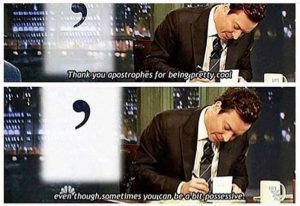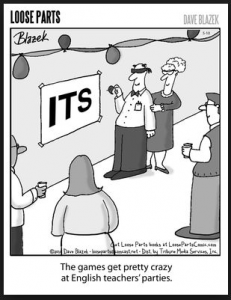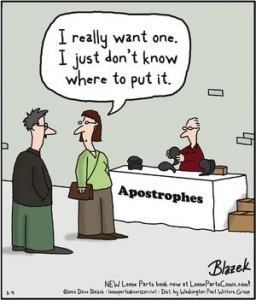
“There’s a big difference between knowing your sh*t and knowing you’re sh*t.”
Access Marketing Company Grammar Corner
Featuring: Apostrophes
Apostrophes can be tricky devils, even for native English speakers. However, they aren’t too tough to master if you can remember two main rules.
-
Apostrophes for Possessives
The formula here is relatively simple. To show that a person or thing owns or is a member of something, add an apostrophe + S (‘s).
Hillary’s guitar, Wendy’s fried chicken, your mom’s house
Note: Even if the name ends in “s,” it’s still correct to add another “‘s” to create the possessive form. It is also acceptable to add only an apostrophe to the end of singular nouns that end in “s” to make them possessive. In this case, you can show possession for Ross either way:
Ross’s car
Ross’ car
Though if you just ignore the second option, you only have one rule to remember so far – add “‘s” to anything singular.
It makes no difference whether the item owned is singular or plural. We use “Ross’s” to say that the room (singular) is his or that the sports teams (plural) are his.
Use an apostrophe after the “s” at the end of a plural noun to show possession (when that word ends in s).
The parents’ bedroom, the Smiths’ lives
-
Apostrophes for Contractions
When you combine two words to make a contraction, you will always take out some letters. In their place, use an apostrophe.
they + have = they’ve; are + not = aren’t; they + will = they’ll
The one exception to this rule is the contraction “won’t,” which is “will + not.” (yeah, English can be a b’ch)
When Not to Use Apostrophes
The apostrophe likes to go against the grain. They seem simple and straightforward—they’re either used to show possession or to create a contraction—but don’t be fooled by this teeny mark. People misunderstand them left and right.
That’s why I’m going to show you how NOT to use an apostrophe by laying out some common errors. Knowing these will help you learn the difference between knowing your sh*t and knowing you’re sh*t.
Contraction Catastrophes
Contractions were probably created to make language more functional. They tighten up words, offering an evasion from redundancy and over-usage. While contractions do service the language, they are commonly misprinted. Here are some examples:
It’s vs. Its
In the land of texting, where we shorten “you” to “u”, it’s no surprise we often skip the apostrophe turning “it’s” to “its.”
It’s (it is) your responsibility to be a grammar queen.
Any time you have an “it’s” or an “its” in your writing, double check the sentence. Unless you can say “it is” in its place, then you do NOT need the apostrophe.

There vs. Their vs. They’re
Remembering that apostrophes mainly like to hang out with contractions, there’s only one time an apostrophe enters into the there/their/they’re family.
There is an apostrophe over there.
They’re (they are) not playing well with apostrophes.
Apostrophe usage is not their strong suit.
If you’re talking about something in a certain place (there) or something that belongs to people (their) you do NOT need to use an apostrophe.
Who’s vs. Whose
Here’s another misunderstood contraction. We have “who’s”, contraction of “who is”, and “whose”, a personal pronoun.
Who’s (who is) going to love me if I can’t get my apostrophes right?
Whose apostrophe is this?
Unless you can use “who is” instead of “who’s” in the sentence, nix the apostrophe.
Your vs. You’re
Just in case we didn’t drive the contraction thing home yet, let’s look at one more common error that makes every editor, professor and literature nerd cringe.
Your apostrophe usage is spectacular.
You’re (you are) not demonstrating a firm grasp of your apostrophe usage.
Similar to the “its vs. it’s” premise, just double check your sentences. Unless you can say “you are” in its place, then ditch the high comma. (And let’s not forget “yore” … when you’re talking about days of yore. Just to bring in something from left field.)
On a Date
1930s vs. 1930’s vs. ’30s
Everyone loves a hot debate, right? Well this is the hottest one in town! Do you put an apostrophe after a date like the one above? Well, there’s really no need for such heated conversation, as you only have to ask yourself three quick questions. Is it a contraction? Is it indicating something missing? Is it showing possession? Let’s take a look:
You could say the 1930’s best songs were written by many great composers. (Possession)
The ’30s were great years for jazz and swing music. (Indicates omission)
The 1930s were a great time for music and dance. (No possession, just a plural)
Let’s Get Plural
Store signs have been notorious over the years for grammar errors. What’s wrong with these signs?
Bob’s Cheesesteak’s and Cubano’s
Smith’s Greengrocer’s: The Best in Town
Often, apostrophes mistakenly find their way into plurals. Remember, if it’s a contraction or a possession, only then are apostrophes on the guest list. So the signs above should read:
Bob’s Cheesesteaks and Cubanos
Smith’s Greengrocers: The Best in Town
Possess Apostrophe Power
Apostrophes are finicky little things that only like to express their jubilation when the timing is right. So only two occasions will give them cause to hop out into the limelight: contractions and possessions. If we can all remember that, then we’re one step closer to becoming apostrophe aficionados, and who wouldn’t like a title like that?
For more writing tips, check out:
- Title Case vs. Sentence Case
- Comma Confidence: Lessons in Using Commas Like a Boss
- Commonly Misused Words That Destroy Your Credibility
HILLARY SUSZ
CONTENT DEVELOPER
Hillary brings her background in marketing, academia and the arts to deliver eye popping content that’s not only engaging but necessary. When it comes to her writing (and maybe her personality, too), the message is not hidden. It’s there for you, bright and clear, communicating vital material.








